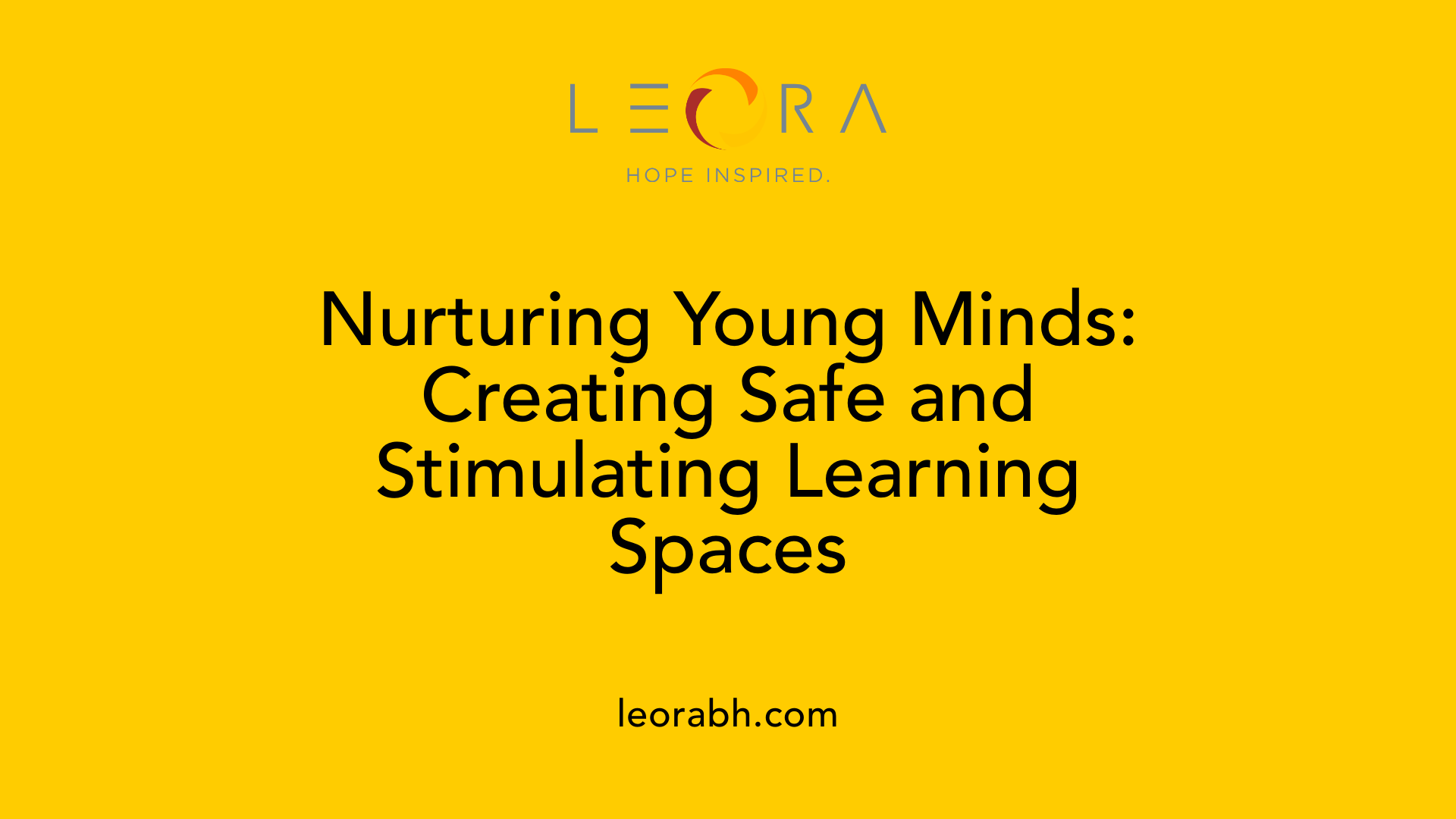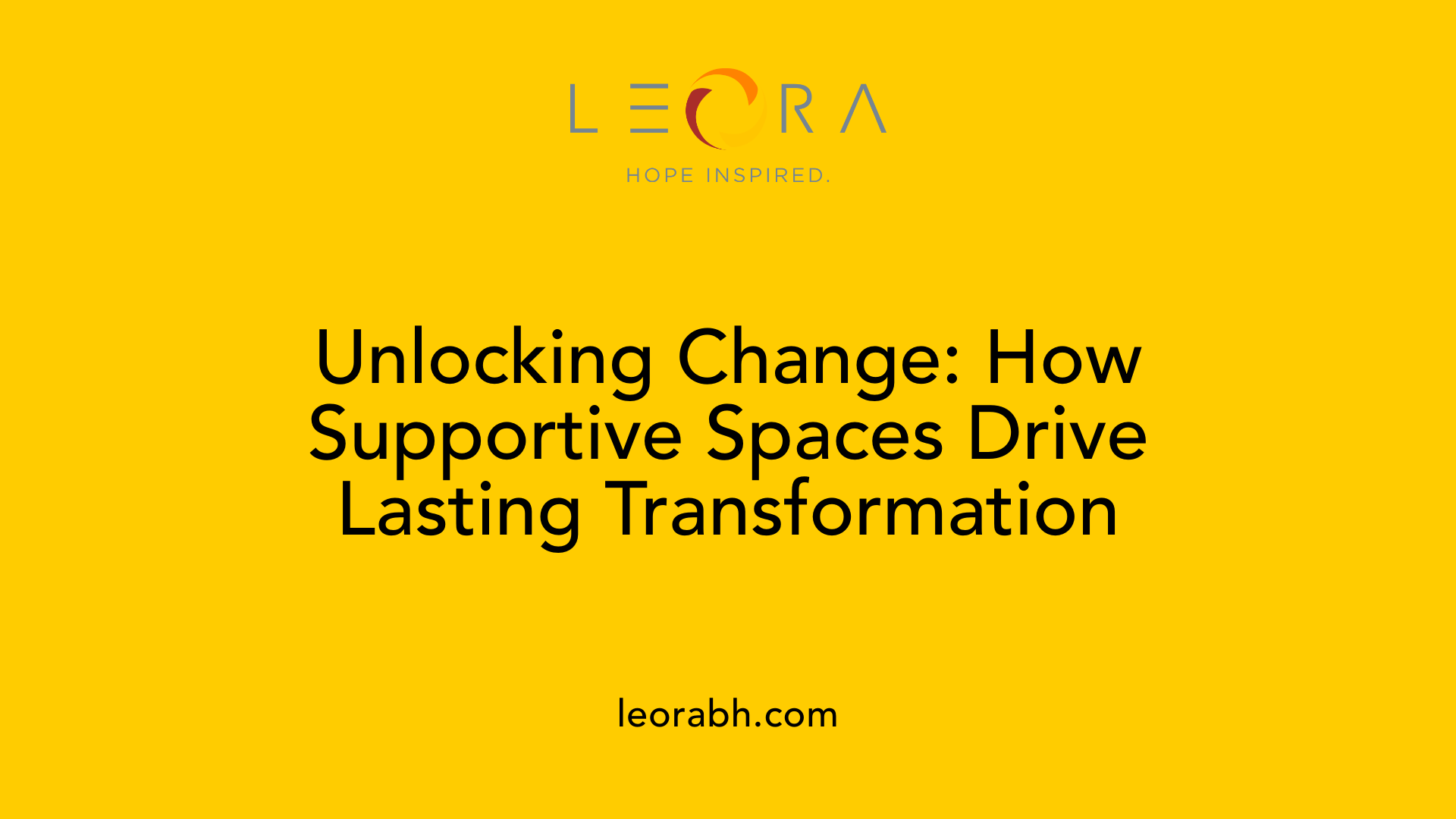Why a Supportive Environment Encourages Lasting Change
Creating Foundations for Sustainable Transformation
Understanding the Power of Supportive Environments
Supportive environments are the cornerstone of lasting change across various settings, including workplaces, schools, communities, and personal spaces. These environments nurture trust, safety, and motivation, serving as catalysts for behavioral, emotional, and psychological transformation. This article explores why cultivating a supportive environment is essential for sustainable progress, detailing mechanisms, strategies, and the profound impact on individuals and organizations alike.
The Importance of Supportive Environments in Fostering Change
Why is a supportive environment important?
A supportive environment plays a vital role in behavior change and personal growth. It provides emotional support, constructive feedback, and a network of individuals who believe in your goals. Such environments foster a sense of belonging and emotional safety, which are essential for motivation and engagement.
Supportive settings encourage positive social interactions and open communication, helping individuals feel heard, valued, and accepted. This sense of validation can boost self-esteem, reduce stress, and increase resilience against challenges.
Research on psychological safety highlights that when people feel secure enough to share ideas, voice concerns, or admit mistakes without fear of criticism, organizations become more innovative and productive. Leaders and peers who actively promote inclusivity and empathy contribute to creating these secure environments.
Creating a nurturing space involves simple but impactful actions, such as providing encouragement, celebrating achievements, and addressing barriers. Overall, such environments help individuals and groups develop the confidence and motivation needed for lasting change.
Role of emotional support in change
Emotional support is a cornerstone of effective behavior change. It reduces feelings of anxiety and stress, empowering individuals to take risks and persist through setbacks. When a person feels supported, they are more likely to embrace new habits and maintain their progress.
Supportive environments also include practical elements, such as access to resources and positive reinforcement, which further bolster motivation. This comprehensive support network helps individuals navigate the complexities of change, making the journey less daunting.
Impact of positive feedback and encouragement
Consistent positive feedback and encouragement foster self-efficacy, or the belief in one's ability to succeed. When individuals receive recognition for their efforts and progress, their confidence grows, leading to increased motivation and perseverance.
Encouragement nurtures a growth mindset, emphasizing effort and learning over failure. In organizational or educational settings, celebrating small wins and providing constructive suggestions reinforce commitment and help maintain momentum.
Network of belief and validation
A network of belief—where peers, mentors, or team members validate each other's efforts—creates a powerful environment for change. Feeling supported by others who share similar goals or values enhances the sense of community and belonging.
This validation reduces self-doubt and promotes a resilient attitude. When people believe that their environment supports their aspirations, they are more likely to take initiative and sustain their efforts over time.
In summary, a nurturing environment combines emotional support, positive reinforcement, and a community of validation. Such settings are proven to enhance motivation, boost engagement, and increase the likelihood of long-term success in personal and organizational change initiatives.
Supportive Environments in the Workplace and Their Benefits

Why is a supportive work environment important?
A supportive work environment plays a crucial role in promoting employee well-being, satisfaction, and motivation. When individuals feel valued, respected, and heard, they are more likely to engage actively with their tasks and contribute creatively to organizational goals. This positive atmosphere fosters trust and collaboration, which enhances overall productivity.
Providing ongoing training and skill development opportunities encourages employees to grow professionally. It helps them stay current with industry trends and enhances their ability to perform their roles effectively. Skill development also cultivates a sense of accomplishment and loyalty, reducing staff turnover and building a resilient workforce.
Ensuring workplace safety and adhering to legal requirements through proper training minimize accidents and legal risks. This not only protects employees but also maintains the organization’s reputation.
A culture that values growth, learning, and safety naturally encourages innovation and high-quality outputs. When employees are supported holistically, organizations benefit from increased efficiency, adaptability, and a stronger competitive edge.
For a comprehensive understanding, organizations can explore how a supportive workplace culture positively impacts various aspects, including employee satisfaction, safety, and organizational innovation.
Creating Nurturing Environments for Children and Education

Why is a supportive environment important for children's development?
A supportive environment is crucial in shaping children's development because it offers a safe and trusting space where young individuals can freely explore, learn, and grow. Such environments foster confidence, allowing children to navigate new experiences without fear of criticism or failure.
In early childhood education, this foundation is vital. When children feel secure and valued, they are more inclined to engage actively with their surroundings, which promotes curiosity and encourages a lifelong love of learning.
Supportive settings also serve to develop essential cognitive and social skills. Children learn to communicate, cooperate, and solve problems through positive interactions and encouragement.
Furthermore, nurturing environments bolster emotional resilience. They help children manage stress, bounce back from setbacks, and develop healthy relationships with peers and adults.
Overall, these environments nurture the whole child—supporting emotional safety, social competence, and academic success. The result is a well-rounded development that prepares children for future challenges and opportunities.
Types of environments fostering children's growth
| Environment Type | Focus | Benefits | How It Supports Development |
|---|---|---|---|
| Safe and Trusting | Physical, emotional, and psychological safety | Confidence in exploration and learning | Reduces anxiety, encourages curiosity |
| Stimulating | Cognitive and sensory engagement | Enhances creativity, critical thinking, problem-solving | Promotes intellectual curiosity and innovation |
| Inclusive | Diversity, equity, respect | Builds empathy, social skills | Prepares children for diverse societies |
| Supportive | Emotional encouragement, feedback | Fosters self-esteem and resilience | Helps children cope with setbacks |
Practical strategies to create positive learning experiences
- Assess social networks: Understand the support systems children have at home and school.
- Encourage goal sharing: Help children set and share achievable objectives.
- Facilitate group activities: Promote teamwork and communication.
- Develop supportive physical spaces: Create inviting areas with comfortable seating, plants, and quiet zones.
- Model supportive behaviors: Teachers and caregivers should demonstrate respect, kindness, and active listening.
- Build emotional safety through routines: Consistent routines and positive communication foster trust.
- Celebrate achievements: Recognize effort and progress to boost motivation.
- Address barriers: Identify and help overcome challenges such as learning difficulties or social conflicts.
How supportive environments enhance motivation and engagement
Creating a nurturing environment not only ensures children's safety but also boosts motivation by making learning enjoyable and meaningful. When children feel trusted and respected, they are more likely to participate actively and persist through challenges.
Such environments elevate engagement levels—research shows that students thriving in supportive settings show up to 70% more engaged and experience a 50% reduction in disciplinary issues.
By fostering psychological safety, inclusive learning, and open communication, educators cultivate an atmosphere where children are willing to take risks, share ideas, and develop critical social and emotional skills that benefit their entire developmental trajectory.
Final overview
| Aspect | Description | Impact |
|---|---|---|
| Safe spaces | Physical and emotional security for exploration | Confidence, reduced anxiety |
| Cognitive engagement | Stimulating activities and learning opportunities | Curiosity, creativity |
| Emotional support | Positive reinforcement, recognition of efforts | Self-esteem, perseverance |
| Interpersonal skills | Collaborative tasks, respectful dialogue | Empathy, communication |
Fostering nurturing environments in education involves creating spaces that are safe, stimulating, inclusive, and emotionally supportive. Such environments lay the foundation for children to develop cognitively, socially, and emotionally, ultimately guiding them toward a fulfilling and successful future.
Mechanisms Through Which Supportive Environments Promote Behavior Change

What mechanisms do supportive environments provide to promote behavior change?
Supportive environments foster lasting behavior change by fulfilling fundamental psychological needs—autonomy, competence, and relatedness. When individuals feel a sense of control over their choices (autonomy), capable of effectively managing tasks (competence), and connected to others (relatedness), their intrinsic motivation to change increases.
These environments facilitate engagement through collaborative and respectful communication styles. Techniques such as open-ended questions, active listening, and unconditional positive regard create a welcoming atmosphere that encourages honesty and self-exploration. Such trust-building strategies reduce fear of judgment, making individuals more receptive to change.
Environmental cues are also crucial. Carefully designed space layouts, consistent routines, and structured activities provide stability, organization, and predictability, which help individuals feel secure and motivated. These cues promote positive patterns of behavior and reinforce the desired change.
Social factors play a significant role as well. Strengthening social support, fostering group cohesion, and cultivating a community atmosphere leverage social norms and peer influence to encourage healthy behaviors. Support from others not only enhances motivation but also sustains efforts over time.
Understanding the neurobiological and motivational mechanisms behind behavior change allows for the development of targeted interventions. Techniques like specific behavior change techniques, environmental modifications, and reinforcement strategies aim to activate brain pathways related to motivation, reward, and learning, leading to more durable change.
In essence, supportive environments operate on multiple levels—psychological, social, and biological—to create conditions that facilitate, reinforce, and sustain behavior change.
Supporting Strategies in Practice
| Strategy | Description | Expected Outcome |
|---|---|---|
| Promoting autonomy | Allowing choice and ownership of goals | Increased intrinsic motivation |
| Enhancing competence | Providing skill-building opportunities | Greater confidence and capability |
| Fostering relatedness | Building trusting relationships and social bonds | Improved engagement and persistence |
| Environmental structuring | Designing spaces and routines that support consistency | Stability and predictability in behaviors |
| Leveraging social influence | Encouraging group activities and peer support | Reinforced social norms and motivation |
By integrating these mechanisms and strategies, supportive environments become powerful catalysts for initiating and maintaining meaningful behavior change.
The Role of Social Support and Community in Sustaining Long-Term Change
How do social support and community influence the sustainability of long-term change?
Social support and community are fundamental factors that help maintain positive behaviors and social initiatives over time. They build what is known as social capital—a network of trust, shared values, and collaboration among community members. When people feel connected and included, they are more likely to work together towards common goals.
A strong, engaged community fosters social cohesion, where respect and fairness are widely upheld. This environment encourages individuals to stick to healthy habits or community projects because they feel valued and supported. Qualities like honesty, mutual respect, and trust are essential in strengthening these bonds.
Communities that actively promote participation and uphold social norms such as social responsibility create a moral groundwork for collective efforts. When members recognize that their actions contribute to a shared purpose, they are motivated to sustain their efforts even during setbacks.
Shared values play a crucial role in cementing long-term sustainability. Initiatives rooted in fundamental community beliefs—like fairness, solidarity, or environmental care—are more likely to resonate and persist.
Moreover, the concept of collective action emphasizes the importance of community involvement in addressing common challenges. By working together, leveraging social norms, and fostering a sense of moral obligation, communities can adapt to changes, overcome obstacles, and continue developing social well-being.
Research underscores that these social dynamics not only facilitate initial change but also maintain momentum over time. Supportive relationships, rooted in trust and respect, empower community members to test new ideas, innovate, and resist reversion to old, less sustainable behaviors.
In essence, a community's social fabric—built on trust, shared norms, and collective effort—serves as a resilient backbone for enduring social progress. When communities embrace participation and align on core values, they create a strong environment for lasting positive change.
Strategies and Methods to Develop Supportive Environments for Long-Term Change
What strategies can be used to develop supportive environments for long-term change?
Creating supportive environments that foster sustainable change requires a combination of practical, relational, and organizational strategies. One fundamental approach is fostering open communication. This can be achieved through regular team meetings, anonymous feedback channels, and clear, consistent messaging. Open dialogue encourages trust, helps identify barriers, and promotes collaborative problem-solving.
Building trust and inclusivity is also vital. Leaders and team members can demonstrate transparency, actively listen, and respect diverse perspectives. Cultivating psychological safety—where individuals feel comfortable expressing ideas and concerns without fear of criticism—strengthens bonds and promotes risk-taking essential for innovation.
Implementing feedback and continuous improvement mechanisms further solidifies a supportive environment. Practices like regular huddles, performance reviews, and T-plans allow for ongoing reflection, celebration of progress, and adjustment of strategies. These routines foster a growth mindset and resilience among participants.
Supporting leadership and organizational culture plays a critical role. Leaders who model supportive behaviors, provide guidance, and recognize contributions set the tone. Establishing core values centered around respect, collaboration, and development guides decision-making and daily interactions.
Additionally, integrating evidence-based frameworks such as the NHS Sustainability Model helps organizations focus on factors that promote long-term success. Visual management tools, process standardization, and policy changes—like modifying physical spaces or advocating for supportive legislation—are practical steps that reinforce a nurturing environment.
Community engagement and environmental modifications, like creating welcoming physical spaces and strengthening local resources, also empower individuals to maintain healthy behaviors. Recognizing that supportive environments are dynamic, organizations must commit to ongoing assessment, feedback, and adaptation to meet evolving needs.
In summary, effective strategies include fostering open dialogue, building trust, embedding continuous improvement, and cultivating leadership that champions a positive, inclusive culture. Together, these efforts establish a resilient environment conducive to lasting behavioral and organizational change.
Psychological Safety as a Foundation for Change

What role does psychological safety play as a foundation for organizational or personal change?
Psychological safety is a fundamental element that underpins successful change efforts, whether in organizations or personal development. It creates an environment where individuals feel secure enough to express their thoughts, ideas, and concerns without fear of criticism or reprisal. This sense of safety fosters open communication, collaboration, and trust among team members or within oneself.
When psychological safety is present, people are more willing to take risks, propose new ideas, and challenge the status quo. They view mistakes not as failures but as opportunities to learn and grow. This mindset encourages continuous improvement and innovation, both of which are vital for adapting to change.
In workplaces, psychological safety enhances employee engagement and well-being. When team members trust their leaders and peers, it boosts morale and commitment during challenging transitions. For individuals, feeling safe emotionally can lower anxiety and resistance, making personal transformation efforts more effective.
Leaders and change agents who cultivate psychological safety often do so by demonstrating vulnerability, actively listening, providing honest feedback, and modeling inclusive behaviors. This approach helps dismantle hierarchies and barriers, encouraging honest dialogue and collective problem-solving.
Research from Harvard Business Review highlights that teams with high psychological safety are more creative, collaborative, and willing to experiment, which directly supports successful change initiatives. Overall, fostering psychological safety lays a strong foundation for sustainable growth and resilience in both organizational and personal contexts.
Impact of Supportive Environments on Mental Health and Personal Development
How can supportive environments impact mental health and personal development?
Supportive environments play a crucial role in promoting mental health and fostering personal growth. They offer individuals a sense of stability and safety, which are fundamental for emotional resilience and overall well-being.
One significant aspect of these environments is the presence of natural elements, such as greenery and water bodies. Research shows that access to high-quality natural spaces, often called blue and green spaces, can help reduce stress and evoke feelings of calmness and happiness. The emotional bond people develop with nature contributes positively to their psychological health.
Features like biodiverse environments, which include plants and animals, as well as thoughtfully designed spaces that prioritize autonomy, privacy, and sensory engagement, support mental wellness. Such settings encourage exploration, relaxation, and emotional reflection, aiding in recovery from stress or trauma.
However, negative environmental conditions can undermine mental health. Pollution, excessive noise, overcrowding, and social inequalities create stressors that heighten anxiety and risk of mental health issues. These adverse factors are especially harmful for vulnerable populations who may lack access to supportive spaces.
Creating environments that are accessible, safe, and filled with natural elements—paired with intentional design—can foster ongoing personal development. They help individuals build resilience, recover from mental fatigue, and develop a positive outlook. Ultimately, the integration of nature, thoughtful space planning, and social support within environments significantly enhances mental health and personal growth.
| Aspect | Impact | Additional Details |
|---|---|---|
| Natural elements | Stress reduction, mood improvement | Access to greenery and water promotes relaxation |
| Thoughtful design | Autonomy, privacy, sensory engagement | Helps in emotional regulation and recovery |
| Negative environmental factors | Increased stress, mental health risks | Pollution, noise, and overcrowding contribute to stress |
| Overall environment quality | Resilience, personal growth, recovery | Supportive environments nurture well-being and development |
A nurturing environment is vital for mental health, enabling individuals not only to cope more effectively with life's challenges but also to thrive and achieve their full potential.
Leadership, Culture, and Environment Design as Support for Change
How do leadership, organizational culture, and environment design influence support for change?
Leadership plays a crucial role in shaping the support system for organizational change. Effective leaders set a compelling vision and demonstrate behaviors that align with the change goals. Their transparency and active communication foster trust among employees, encouraging a shared commitment to new initiatives.
Organizational culture also significantly influences how change is perceived and adopted. A culture rooted in shared values, openness, and innovation promotes adaptability. When employees perceive that the organization values learning, experimentation, and resilience, they are more likely to engage positively with change efforts.
The physical and social environment further supports change by creating conditions that reinforce cultural values and leadership messages. This includes designing clear communication channels, recognition and reward systems that motivate desired behaviors, and physical spaces that cultivate collaboration and openness.
The synergy of strong leadership, supportive culture, and well-designed environments fosters a resilient organization. It not only reduces resistance but also enhances the capacity to implement lasting change, promote innovation, and sustain organizational growth.
| Component | Influence on Change Support | Key Features |
|---|---|---|
| Leadership | Sets vision, models behavior, builds trust | Transparency, active communication, leading by example |
| Culture | Shapes attitudes, promotes engagement | Shared values, promotes innovation, learning orientation |
| Environment | Reinforces culture, facilitates behaviors | Communication channels, reward systems, physical workspace |
Together, these elements create a resilient organizational framework capable of embracing ongoing changes and sustaining long-term success.
Evidence Supporting the Benefits of Supportive Settings in Lasting Transformation
Supportive environments are proven to be vital for sustaining meaningful change across various domains, including healthcare, education, and community initiatives.
Research in healthcare settings highlights that environments which emphasize collaboration, role modeling, and empowerment contribute significantly to behavior change. For example, implementing a coach approach—where professionals foster motivation through positive reinforcement and active listening—has demonstrated improvements in patient well-being, self-efficacy, and long-term health habits.
Community-based initiatives further reinforce that involving local stakeholders and fostering participatory programs can enhance the durability of health interventions. The supersetting approach is a well-recognized model that integrates efforts across multiple sectors, creating a cohesive and supportive environment. This approach encourages community engagement, shared responsibility, and resource pooling, all of which bolster the sustainability of health and social programs.
Additional evidence from systematic reviews confirms that environments characterized by psychological safety, open communication, and opportunities for collaboration have higher success rates in fostering lasting transformation. Such settings enable individuals to take risks, learn from mistakes, and stay committed to their goals.
Across all sectors, organizations that prioritize cultivating supportive climates—through fostering trust, encouraging innovation, and providing continuous support—see improvements not only in motivation but also in health outcomes, resilience, and overall well-being.
In summary, the body of evidence underscores that creating environments rich in support, trust, and participation is essential for achieving durable transformation. This involves integrating systemic strategies, community involvement, and ongoing mentorship—factors that collectively nurture sustainable change and long-term success.
| Source | Focus Area | Impact Demonstrated |
|---|---|---|
| Healthcare studies | Clinical environments | Increased patient motivation and adherence |
| Community programs | Participatory initiatives | Improved health outcomes and community resilience |
| Systematic reviews | Organizational culture | Higher rates of sustained behavior change |
| Supersetting models | Multi-sector collaboration | Long-term health promotion and social cohesion |
Building Resilience Through Support and Environment
A supportive environment is the foundation upon which lasting change is built. It nurtures trust, safety, and motivation, empowering individuals and organizations to overcome challenges and pursue continuous growth. By fostering psychological safety, encouraging social support, and designing spaces that promote well-being, we create resilient communities capable of adapting and thriving in the face of change. Emphasizing leadership, culture, and strategic planning ensures that support remains embedded within the fabric of organizational and social life. Only through such comprehensive support can transformation be sustainable, meaningful, and truly impactful.
References
- Social Support and Behavioral Change and Motivation
- Supportive Environments: Building the Foundation for Success
- A Supportive Classroom Environment - Casel Schoolguide
- The Power of Psychological Safety to Create Sustainable Change
- Creating Lasting Impact: Strategies for Positive Behavior Change ...
- Creating a Supportive Environment with Family and Friends
- How to Build a Supportive Environment During Workplace Changes
- Creating a Supportive Environment for Organizational Change
Find Your Inner Light
Related Articles
Schedule an Assessment
Leora Behavioral Health provides comprehensive treatment services, including ambulatory detox, mental health IOP, and SUD IOP, to support your journey toward lasting recovery.
Our caring team will guide you through the admissions process and create a personalized treatment plan tailored to your unique needs. We welcome walk-ins. If you or a loved one is struggling, reach out today. We’re here to help.


.svg)




.svg)
.svg)
.svg)
.svg)
